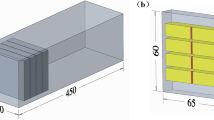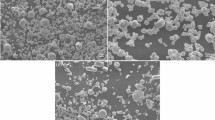Abstract
Ultra-high temperature ceramic (UHTC) composites are widely used in high-temperature environments in aerospace applications. They experience extremely complex environmental conditions during service, including thermal, mechanical and chemical loading. Therefore, it is critical to evaluate the mechanical properties of UHTCs subject to an environment with elevated temperature, mechanical stress and oxygen. In this paper, an experimental investigation of the uniaxial tensile properties of a ZrB2-SiC-graphite subject to an environment with a simultaneously elevated temperature, mechanical stress and oxygen is conducted based on a high-temperature mechanical testing system. To improve efficiency, an orthogonal experimental design is used. It is suggested that the temperature has the most important effect on the properties, and the oxidation time and stress have an almost equal effect. Finally, the fracture morphology is characterized using scanning electron microscopy (SEM), and the mechanism is investigated. It was concluded that the main fracture mode involved graphite flakes pulling out of the matrix and crystalline fracture, which indicates the presence of a weak interface in the composites.
Similar content being viewed by others
References
Yang Y, Yang J, Fang D. Research progress on thermal protection materials and structures of hypersonic vehicles. Appl Math Mech-Engl Ed, 2008, 29: 51–60
Wuchina E, Opila E, Opeka M, et al. UHTCs: Ultra-high temperature ceramic materials for extreme environment applications. Electrochem Soc Interface, 2007, 16: 30
Monteverde F, Bellosi A, Scatteia L. Processing and properties of ultra-high temperature ceramics for space applications. Mater Sci Eng-A, 2008, 485: 415–421
Upadhya K, Yang J M, Hoffman W P. Advanced materials for ultrahigh temperature structural applications above 2000°C. Am Ceram Soc Bull, 1997, 76: 51–56
Tandon R, Dumm H P, Corral E L, et al. Ultra high temperature ceramics for hypersonic vehicle applications. Sandia National Laboratories, 2006
Guo S Q. Densification of ZrB2-based composites and their mechanical and physical properties: A review. J Eur Ceramic Soc, 2009, 29: 995–1011
Zimmermann J W, Hilmas G E, Fahrenholtz W G, et al. Thermo-physical properties of ZrB2 and ZrB2-SiC ceramics. J Am Ceramic Soc, 2008, 91: 1405–1411
Opeka M M, Talmy I G, Wuchina E J, et al. Mechanical, thermal, and oxidation properties of refractory hafnium and zirconium compounds. J Eur Ceramic Soc, 1999, 19: 2405–2414
Fahrenholtz W G, Hilmas G E, Talmy I G, et al. Refractory diborides of zirconium and hafnium. J Am Ceramic Soc, 2007, 90: 1347–1364
Rahman M, Wang C C, Chen W, et al. Electrical resistivity of titanium diboride and zirconium diboride. J Am Ceramic Soc, 1995, 78: 1380–1382
Mishra (Pathak) S K, Das S, Das S K, et al. Sintering studies on ultrafine ZrB2 powder produced by a self-propagating high-temperature synthesis process. J Mater Res, 2000, 15: 2499–2504
Opeka M M, Talmy I G, Zaykoski J A. Oxidation-based materials selection for 2000°C+hypersonic aerosurfaces: Theoretical considerations and historical experience. J Mater Sci, 2004, 39: 5887–5904
Chamberlain A L, Fahrenholtz W G, Hilmas G E, et al. High-strength zirconium diboride-based ceramics. J Am Ceramic Soc, 2004, 87: 1170–1172
Rezaie A, Fahrenholtz W G, Hilmas G E. Effect of hot pressing time and temperature on the microstructure and mechanical properties of ZrB2-SiC. J Mater Sci, 2007, 42: 2735–2744
Watts J, Hilmas G, Fahrenholtz W G. Mechanical characterization of ZrB2-SiC composites with varying SiC particle sizes. J Am Ceramic Soc, 2011, 94: 4410–4418
Wang Z, Hong C, Zhang X, et al. Microstructure and thermal shock behavior of ZrB2-SiC-graphite composite. Mater Chem Phys, 2009, 113: 338–341
Zhou S, Wang Z, Zhang W. Effect of graphite flake orientation on microstructure and mechanical properties of ZrB2-SiC-graphite composite. J Alloys Compd, 2009, 485: 181–185
Zhang X, Wang Z, Sun X, et al. Effect of graphite flake on the mechanical properties of hot pressed ZrB2-SiC ceramics. Mater Lett, 2008, 62: 4360–4362
Wang Z, Wang S, Zhang X, et al. Effect of graphite flake on microstructure as well as mechanical properties and thermal shock resistance of ZrB2-SiC matrix ultrahigh temperature ceramics. J Alloys Compd, 2009, 484: 390–394
Wang L, Liang J, Fang G. High temperature fracture behavior of ZrB2SiC-graphite composite in vacuum and air. J Alloys Compd, 2015, 619: 145–150
Chen H, Wang Z, Meng S, et al. The failure mechanism of ZrB2-SiC-graphite composite heated by high electric current. Mater Lett, 2009, 63: 2346–2348
Zhi W, Zhanjun W, Guodong S. Effect of annealing treatment on mechanical properties of a ZrB2-SiC-graphite ceramic. Mater Sci Eng-A, 2011, 528: 2870–2874
Zhi W, Qiang Q, Zhanjun W, et al. Effect of oxidation at 1100°C on the strength of ZrB2-SiC-graphite ceramics. J Alloys Compd, 2011, 509: 6871–6875
Jin H, Meng S, Zhang X, et al. Effects of oxidation temperature, time, and ambient pressure on the oxidation of ZrB2-SiC-graphite composites in atomic oxygen. J Eur Ceramic Soc, 2016, 36: 1855–1861
ASTM: C1366-97: Standard Test Method for Tensile Strength of Monolithic Advanced Ceramics at Elevated Temperatures. ASTM International. West Conshohocken, 1997
ASTM: C1273-95a: Standard Test Method for Tensile Strength of Monolithic Advanced Ceramics at Ambient Temperatures. ASTM International. West Conshohocken, 2000
Author information
Authors and Affiliations
Corresponding author
Rights and permissions
About this article
Cite this article
Han, X., Xu, C., Jin, H. et al. An experimental study of ultra-high temperature ceramics under tension subject to an environment with elevated temperature, mechanical stress and oxygen. Sci. China Technol. Sci. 62, 1349–1356 (2019). https://doi.org/10.1007/s11431-018-9501-1
Received:
Accepted:
Published:
Issue Date:
DOI: https://doi.org/10.1007/s11431-018-9501-1




